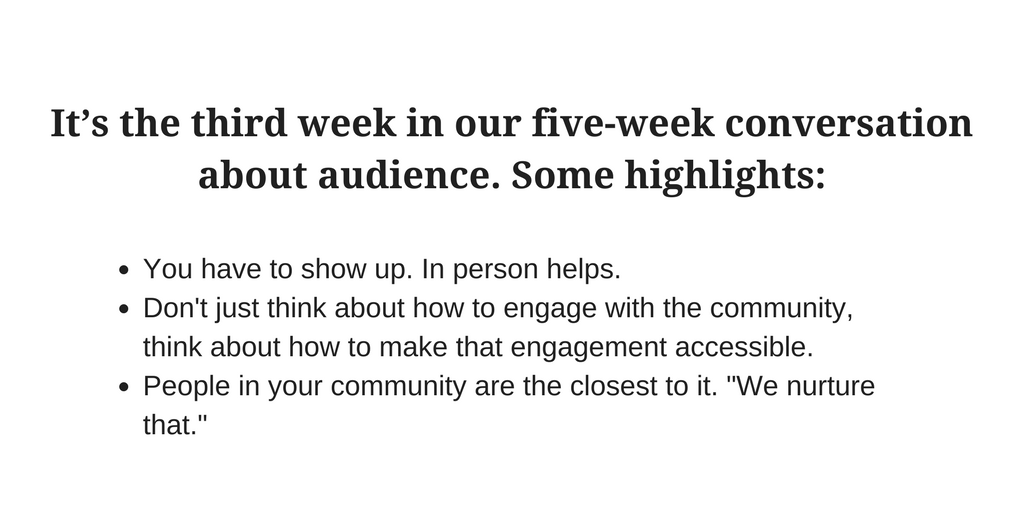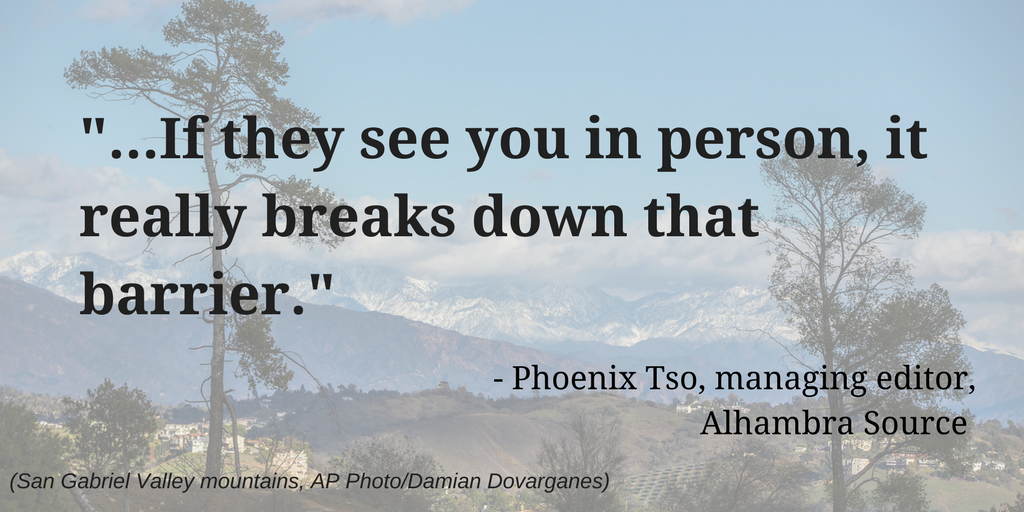This piece originally appeared in Local Edition, our newsletter following the digital transformation of local news. Want to be part of the conversation? You can sign up here.

Local Edition is a few months old, and by now, I have a bit of a warm up that I use to begin interviews.
It goes like this: “We’re going to have a conversation. I’ll pretty much run this as is unless you go on for too long. And I’ll edit a lot of me out because I always go on for too long.”
“OK, going to record now. Ready? Tell us about yourself….”
When I called Phoenix Tso last week, I diverted from that routine.
“Before you tell us about yourself and what you do, will you tell us the lawn bowling story?” I asked.
She was a good sport.
“Yeah, that happened last year,” said the managing editor of California’s Alhambra Source, an online nonprofit that started as a project at the University of Southern California’s Annenberg School for Communication and Journalism.
The short version is this: The city of Alhambra sold some property and had to spend the money it made from the sale that year.
“So they got $8 million and they wanted to spend it on, coincidentally, an $8 million parking structure,” Phoenix said. “They wanted to build this at one of the parks, and they wanted to replace the lawn bowling court with this parking structure … and the lawn bowlers heard about it and started protesting. They organized a lot. They contacted local media, and Alhambra Source was the first to pick up the story.”
Phoenix’s predecessor covered the story, and then Phoenix took over. She did the basic things good reporters do – she went to meetings, she dug through paperwork. But it all started because Alhambra Source listened to the lawn bowlers.
By September of last year, the parking lot plans were squashed. Included in the new plans: $2.5 million in improvements to the existing park, including the lawn bowling greens.
We’re talking about community and audience right now, and this week, we’re discussing it with a journalist who works for an organization that has the goal of informing and empowering community members, including those lawn bowlers.
Our talk was edited for length and clarity. (Like I said, mostly me.)

Please tell us about yourself and your work.
My name is Phoenix. I’m actually from the Boston area but I moved to L.A. three years ago and I went to grad school at USC for journalism. I’ve worked at various New York media publications. Alhambra Source up until July 1 was a USC project, so I got the job through those connections.
I became the editor a year ago. I oversee all the editorial, and that includes a lot of reporting. I also take pitches and guide pitches from contributors.
How big is your staff?
It’s me, editorially. We have a community outreach organizer, and we have a team of the two professors who started the project at USC, and we have a project director who’s also a USC alum employee. I guess all told there are six or seven on the team, but for full-time editorial, it’s me.
Alhambra Source has been around for almost 10 years, right? What’s the history?
It started in 2008. The two professors I was talking about, Sandra Ball-Rokeach and Michael Parks, were doing research in the San Gabriel Valley and they were trying to solve this issue of civic engagement. Out of this research, they decided to start this newspaper, and they chose Alhambra because of its unique ethnic makeup. Over half the population is of Asian descent, and it has a pretty big Latino population, too.
They were finding in Alhambra that a lot of residents were not aware of all of what was going on in the city. I think the year that Alhambra Source started, the city council canceled their election because there was nobody running against the incumbents.
One of the city council members was quoted as saying that Alhambra was really happy with what they were doing so they didn’t need elections.
Wow.
Yeah.
One of our now-board members, Eric Sunada, started by writing articles for the Alhambra Source back when Daniela Gerson was editor. Out of that, he started a non-profit called Grassroots Alhambra and then he ran for city council as an outsider candidate. He lost to Stephen Sham (who’s still on the council) in 2014 by less than 400 votes. This is quite an accomplishment given how Alhambra city council members have to start making connections/raising money years before they decide to run. When I started last year, Sunada wrote a how-to about the city council nomination process. A resident, Ken Toh, was inspired to run from reading that article.
How else have you gone about increasing resident engagement in the community?
We’ve trained residents and high school students, even, to write for us and to report for us, and they’ve really done some great things. Obviously as residents of the community, they’re way closer to the community, so they have a lot of great ideas.
We nurture that. We’ve trained a dedicated team of people who not only write for us but give us tips to follow up on. We’re really committed to growing that.
Right now it’s on a volunteer basis, but we’re also committed to putting some money toward that as well.
What advice do you have for news organizations that want to do better connecting with and for the community? Any tips?
Meet with the community regularly. We have monthly community meetings and that’s for people to talk about their pitches and just what’s on their mind. It’s also about making those meetings accessible. If somebody doesn’t know what a pitch is, they might feel too intimidated.
I don’t actually live in Alhambra, and Alhambra Source doesn’t currently have an office in the city. We all work from home at the moment, but are hoping to be able to raise money or office space as an in-kind donation. But I go there often enough so people see me around and talk to me. Be on the ground and make yourself accessible. Sometimes I just camp out at City Hall.
With the residents, if they see you in person, it really breaks down that barrier.
What will change for you all now that you’re a non-profit? More staff?
We’re definitely trying to hire more people, and we think we can increase our outreach and marketing. And I’m really glad we hired someone to do outreach.
That’s definitely the point of this whole thing. It’s not even for me to write articles. It’s for people who actually live in Alhambra and know Alhambra really well to not just write articles but to really effect change.
To bring it back to the lawn bowlers, that was all them. I think the city really underestimated them. And when they found out, they really organized super quickly. They talked to people in the neighborhood who didn’t want this huge parking structure in their neighborhood.
To just be able to tap into that is what we really want to encourage.
Thank you, Phoenix! Next week is not-a-journalist week, and we’ll be hearing from Jenn Graham, founder of Atlanta’s Civic Dinners.
In the meantime, there’s still time to apply for the 2018 Knight Visiting Nieman Fellowships. Check out what’s working for Hearken newsrooms. And Poynter’s News University has an upcoming Webinar on engaging audience with interactive video.
See you next week!







